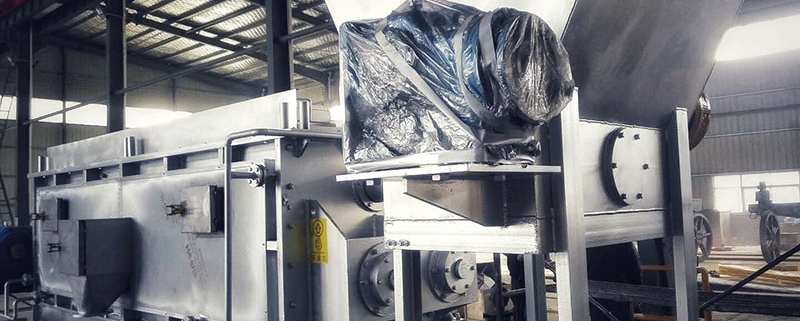The sludge dryer can dry sludge such as domestic sludge, printing and dyeing sludge, paper sludge, electroplating sludge, tannery sludge, petrochemical sludge, etc. Moreover, it can not only dry various types of sludge. It can also dry a variety of high viscosity materials. According to the different ways of contact between the heat medium and the sludge, what is its classification?
According to the contact mode of the heat medium and the sludge: the sludge drying equipment is divided into direct heating, indirect heating and direct and indirect combined heating according to the contact mode of the heat medium and the sludge. Since the direct and indirect combined heating methods are less used in engineering, there are generally two heating methods.
First, direct heating and drying equipment:
Direct drying is the process of heating the sludge by direct contact with the sludge and evaporating the water in the sludge to obtain a dry sludge product. This technology is also called heat convection drying. The direct drying sludge dryer is a direct contact between the heat medium and the sludge, and has a high heat transfer rate, thermal efficiency and evaporation rate. There are drum drying equipment, belt drying equipment, and spray drying equipment.
The representative model is a rotary cylinder dryer with an internal crushing device; a fluidized bed with internals.
Rotary cylinder dryer with internal crushing device
The dryer adopts direct drying technology to directly mix and mix the flue gas with the sludge, so that the water in the sludge can be evaporated and a dry sludge product can be obtained.
The main part of the machine is:
A rotating cylinder that is slightly inclined with respect to the horizontal line, and the drying method adopts a downstream drying method. The material is fed from the upper end of the rotary drum through the feeding device, and the flow rate entering the same end is 1.2-1.3 m/s and the temperature is 700 °C under the flipping of the plate in the drum (5-8 r/min). The hot air flow is contacted and mixed, and the rotating crushing agitating wing is arranged in the middle of the drum, so that the material entering the dryer can be quickly broken, especially the bulk material with certain viscosity can be broken into small pieces so as to be in full contact with the hot air. The drying efficiency is improved, and the small pieces of material are further broken into granules, and after being treated for 20 to 60 minutes, the dried sludge is transported through the discharge port. A dry sludge product having a moisture content of less than 14% is obtained.
Features
Through the composite effect of the crushing agitation device and the cylinder rotation, the total heat transfer coefficient is increased to 2 to 3 times that of the ordinary rotary dryer, and can reach 300 to 500 Kcal/m3•n•°C. The crushing and agitating device crushes the material, and the contact area between the material and the hot air is increased, and the short circuit of the hot air is also prevented, so that the heat of the hot air is fully utilized. As the sludge of the municipal sewage treatment plant is added with flocculant during the dehydration process, the viscosity of the sludge is increased, and it is easy to agglomerate during the drying process, which not only affects the drying effect, but also increases the difficulty of utilization (required) The last set of mud crushing equipment). In the drying equipment, the stirring and crushing device and the kiln movable plate in the cylinder act to make the mud block broken before being hardened, and the discharging material is a powdery granular product, so that the subsequent processing or utilization process of the sludge is more convenient.
Equipment shortcoming
When the sludge enters the dryer, the moisture content is very large, generally about 80%. At this time, the evaporation amount is large and the drying efficiency is higher. However, since it cannot be broken at this time, the sludge has a low degree of contact with hot air and the evaporation efficiency is low. When the crusher is in effect, the moisture content of the material is generally below 40%. At this time, the material has been run to more than half of the rotary cylinder, resulting in insufficient effective space. For occasions with high moisture requirements (such as 50%), the drying efficiency is lower, and it is generally too dry and waste. The exhaust gas exchanged with the sludge is generally discharged into the atmosphere at about 100 degrees, which wastes a large amount of heat source, increases the operating cost, and also causes atmospheric pollution.
Adaptation scale: Rotary cylinder dryer with in-band crushing device, equipment with moderate investment, high civil construction investment, high energy consumption, suitable for single machine processing capacity below 5 tons / hour, final moisture requirement is lower (less than 20 %) in the sludge drying project.
Fluidized bed with internals
The machine adopts a composite heating method of direct heating by hot air and conduction heating of internal parts to continuously dry the sludge, and a heat exchange tube bundle with different layouts is arranged in the fixed fluidized bed, and boiler steam is introduced into the bundle, and the boiler steam is a heating medium. . The air is heated by a steam heater disposed outside the fluidized bed, and then enters the fluidized bed, and the added sludge is blown in the bed to exchange heat, collide, and pulverize with the internal parts. The materials that meet the moisture and particle size requirements are taken out of the dryer by hot air and collected by a cyclone and a bag filter. The unsatisfactory materials are circulated and dried in the dryer.
Features
The internal parts play the role of crushing and conduction heat transfer, so that the fluidized bed which can not dry the sludge can be used to dry the sludge, which has the characteristics of large fluidized bed treatment, and the conductive heating internal parts play a certain energy saving. effect. The drying strength is improved.
Equipment shortcoming
The sludge particles collide with the inner parts for a long time, which shortens the life of the inner parts. There is hot air intervention, taking away heat, increasing energy consumption and increasing operating costs.
Adapt to scale
One-time equipment is moderate investment, civil construction investment costs are high, and energy consumption is too large. It is suitable for single sludge treatment with a capacity of 8 tons/hour and a low moisture content.
Second, indirect heating and drying equipment:
Indirect thermal drying, also known as heat conduction drying, in the process of operation, the heat medium does not directly contact the sludge, but the heat is transferred to the wet sludge through the medium, so that the water in the sludge can be evaporated. There are rotary drying equipment, membrane drying equipment, paddle drying equipment, and multi-layer step drying equipment.
Representative models are: hollow paddle blade dryer, disc dryer.
Hollow paddle dryer
The hollow blade dryer is a horizontal agitating dryer mainly based on heat conduction. Because the inner hollow agitating blade is shaped like a paddle, it is called a hollow blade dryer.
Features of the equipment: adjustable material retention time, can handle high water content materials, can also obtain very low water content materials; typical conduction drying method, energy saving, large transmission coefficient, high thermal efficiency; all the heat required is supplied by hollow blades and jackets, In order to reduce the humidity of the exhaust gas, a small amount of hot air can be added, the dust entrainment is low, the exhaust gas is easy to handle, and auxiliary equipment such as dust removal is not required. The blades have self-cleaning ability. The blades rotate in opposite directions, and the two inclined surfaces of the blade repeatedly stir, compress, relax and propel the material, so that the page has a unique self-cleaning ability, the heating surface is continuously updated, and the heat transfer coefficient of the blade dryer is higher than any other conduction. Drying method.
Disc dryer
The disc dryer is an indirect heated contact dryer designed for viscous products. The heating zone consists of a double-walled disc that is mounted on the hollow shaft at specific intervals; the transport paddle is mounted around the disk, along the axial direction. Transfer material.
Third, direct, indirect combined drying equipment:
The direct, indirect combined drying system is the integration of convection-conduction technology. Common equipment fluidized bed, etc.



